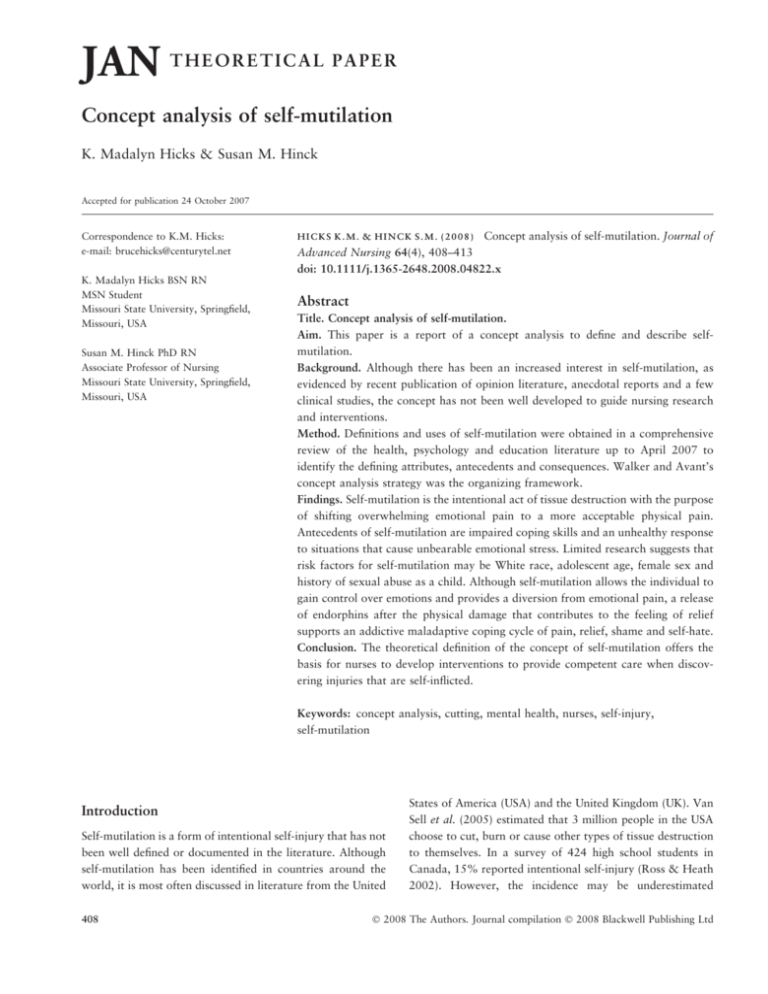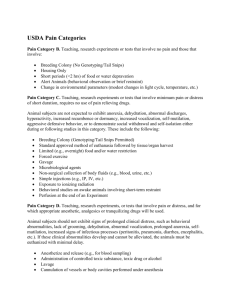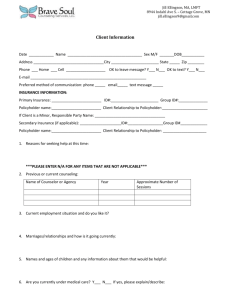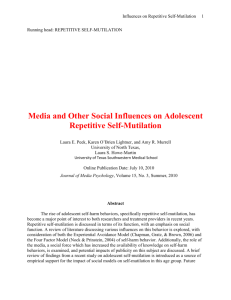Concept analysis of self-mutilation
advertisement

JAN THEORETICAL PAPER Concept analysis of self-mutilation K. Madalyn Hicks & Susan M. Hinck Accepted for publication 24 October 2007 Correspondence to K.M. Hicks: e-mail: brucehicks@centurytel.net K. Madalyn Hicks BSN RN MSN Student Missouri State University, Springfield, Missouri, USA Susan M. Hinck PhD RN Associate Professor of Nursing Missouri State University, Springfield, Missouri, USA H I C K S K . M . & H I N C K S . M . ( 2 0 0 8 ) Concept analysis of self-mutilation. Journal of Advanced Nursing 64(4), 408–413 doi: 10.1111/j.1365-2648.2008.04822.x Abstract Title. Concept analysis of self-mutilation. Aim. This paper is a report of a concept analysis to define and describe selfmutilation. Background. Although there has been an increased interest in self-mutilation, as evidenced by recent publication of opinion literature, anecdotal reports and a few clinical studies, the concept has not been well developed to guide nursing research and interventions. Method. Definitions and uses of self-mutilation were obtained in a comprehensive review of the health, psychology and education literature up to April 2007 to identify the defining attributes, antecedents and consequences. Walker and Avant’s concept analysis strategy was the organizing framework. Findings. Self-mutilation is the intentional act of tissue destruction with the purpose of shifting overwhelming emotional pain to a more acceptable physical pain. Antecedents of self-mutilation are impaired coping skills and an unhealthy response to situations that cause unbearable emotional stress. Limited research suggests that risk factors for self-mutilation may be White race, adolescent age, female sex and history of sexual abuse as a child. Although self-mutilation allows the individual to gain control over emotions and provides a diversion from emotional pain, a release of endorphins after the physical damage that contributes to the feeling of relief supports an addictive maladaptive coping cycle of pain, relief, shame and self-hate. Conclusion. The theoretical definition of the concept of self-mutilation offers the basis for nurses to develop interventions to provide competent care when discovering injuries that are self-inflicted. Keywords: concept analysis, cutting, mental health, nurses, self-injury, self-mutilation Introduction Self-mutilation is a form of intentional self-injury that has not been well defined or documented in the literature. Although self-mutilation has been identified in countries around the world, it is most often discussed in literature from the United 408 States of America (USA) and the United Kingdom (UK). Van Sell et al. (2005) estimated that 3 million people in the USA choose to cut, burn or cause other types of tissue destruction to themselves. In a survey of 424 high school students in Canada, 15% reported intentional self-injury (Ross & Heath 2002). However, the incidence may be underestimated 2008 The Authors. Journal compilation 2008 Blackwell Publishing Ltd JAN: THEORETICAL PAPER because self-mutilation is a hidden, socially unacceptable behaviour. When seeking care for injuries, self-mutilators may not disclose the source of the injury to their healthcare providers. Further, self-mutilation may be misdiagnosed, ignored or under reported by healthcare providers (Abraham & Llardi 2005). Although the media has referred to self-mutilation as the disease of the 1990s (Abraham & Llardi 2005), in the USA, the Diagnostic and Statistical Manual (First 2000) identifies it as a behavioural symptom in stress or borderline personality disorders, and not a specific disease. The term is absent from medical dictionaries (Stedman 2005; Taber 2005). The concept of self-mutilation has not been well developed or consistently used. Aim The aim of this concept analysis was to define and describe self-mutilation. Method The concept of self-mutilation was analysed using the framework of defining attributes, antecedents, consequences and a model case recommended by Walker and Avant (2005). In addition, based on an understanding of the concept, recommendations in the literature about interventions to prevent and treat self-mutilation were discussed. The electronic databases Academic Search Premier, CINAHL, ERIC, Lexis Nexus Academia, Psyc-INFO and STAT!Ref were searched using the keywords self-mutilation, self-injury and cutting for publications prior to April 2007. Inclusion criteria for articles were that they were printed in the English language, in peer reviewed journals and discussed self-mutilation acts. Reference lists of articles were examined to identify references not yielded by the computer search. As a result, two books (Favazza 1996, Strong 1998) were selected and read. The World Wide Web also was searched using the same keywords and inclusion criteria. From the 213 abstracts reviewed, 40 articles were chosen for further evaluation because they were in peer reviewed journals and discussed self-mutilation that was not a suicide attempt or a result of diagnosed mental illness. Twenty-six articles that described self-mutilation sufficiently to provide some definition were retained for inclusion in the concept analysis. Information in the 26 articles and two books were then analysed, coded and displayed in a table to categorize definitions, surrogate terms, defining attributes, antecedents and consequences. Works by authors in the disciplines of nursing, medicine, psychology and religion were found. Concept analysis of self-mutilation Publications were from the USA (13), the UK (eight), Canada (two), Australia (one), China (one) and Sweden (one). Little empirically based literature on individuals that self-mutilate is available, and descriptive design studies only were found (Ross & Heath 2002, Huband & Tantam 2004, Nock & Prinstein 2004, Laye-Gindhu & Schonert-Reichl 2005, Shaw 2006). Self-mutilation has been described mainly through clinical case studies and expert opinion articles. Findings Definition The root word mutilate is derived from the Latin mutilatus, which means to maim. A dictionary definition of mutilate is a verb meaning to inflict a violent and disfiguring injury; to deform by slitting, boring, or removing a part of a body (Merriam-Webster online dictionary 2007). Self-mutilation is deliberate injury to one’s own body. Based on a review of health-related literature, selfmutilation is defined as the intentional act of tissue destruction with the purpose of shifting overwhelming emotional pain to a more acceptable physical pain. Tissue damage is a visual demonstration of extreme emotional distress, and the physical act of mutilation seems to reconcile this emotion. A release of endorphins after the physical damage contributes to a feeling of relief, and an addictive maladaptive coping cycle of pain, relief, shame and self-hate. Body modifications that are intended for ornamentation are not considered a form of self-mutilation, as they are done for spiritual or social purposes. The modification of one’s body by tattooing, piercing or plastic surgery for the purpose of decoration is considered culturally sanctioned and is not measured as a form of self-mutilation (Clarke & Whittaker 1998, Woldorf 2005, Brumberg 2006). The intentional tissue destruction has a purpose, but selfmutilators are not masochists. Masochists find pleasure in pain, while self-mutilators use pain as a means for relief (Clarke & Whittaker 1998). Pain is not the only goal when cutting; it is often the sight of blood that is effective in restoring a sense of authenticity to the disenfranchised individual (Favazza 1996, Glenn & DeNisco 2006, Malikow 2006). The act of self-mutilation is not a suicide attempt, although in 1939 self-mutilation was hypothesized to be a substitute for complete suicide (Clarke & Whittaker 1998, Starr 2004, Woldorf 2005). A person who is attempting suicide wants to die, but a self-mutilator cuts to feel better. It has been said that suicide is a permanent solution to a temporary problem, while self-mutilation is a temporary solution to a permanent 2008 The Authors. Journal compilation 2008 Blackwell Publishing Ltd 409 K.M. Hicks and S.M. Hinck problem (Woldorf 2005). However, self-mutilators are at risk for accidental or intentional suicide, being 18 times more likely to commit suicide (Van Sell et al. 2005). Favazza (1996) classifies self-mutilators as superficial or moderate, major and stereotypic according to the type of activity they perform. Superficial or moderate self-mutilators are most common and are usually found among adolescents. This type of self-mutilation consists of impulsive behaviour such as cutting, burning, carving, interfering with wound healing, and hair plucking. Major self-mutilators are the extreme type and are found in psychotic or intoxicated states. Major destruction is performed on the body such as in the form of eye enucleations, limb amputations and castration. Stereotypic self-mutilators are usually autistics and mentally retarded individuals. They exhibit head banging, self-hitting, orifice digging, throat and eye gouging, self-biting and joint dislocation (Favazza 1996). Surrogate terms Just as there has been no consensus in the literature on the definition of self-mutilation, there is no consensus on the label for this activity. Some of the numerous surrogate terms for self-mutilation are autoaggression (Clarke & Whittaker 1998, Derouin & Bravender 2004), self-abuse (Abraham & Llardi 2005), local self-destruction (Clarke & Whittaker 1998), symbolic wounding (Clarke & Whittaker 1998), focal suicide (Clarke & Whittaker 1998, Woldorf 2005) and para suicide (Clarke & Whittaker 1998, Woldorf 2005). Defining attributes The two defining attributes of physical self-injury and the intent to provide a release of emotional pain are present for all self-mutilators. The self-injury provides for a catharsis of feelings, in settings where emotional oppression and social suffocation are common (Woldorf 2005). There is a contradictory nature to the behaviour of a selfmutilator. The self-mutilation is a visual plea for help, but it is also a source of shame that the person is compelled to repeat in secret (Strong 1998, Derouin & Bravender 2004, Starr 2004). Many self-mutilators have been taught that the thoughts, emotions and feelings others take for granted, such as feelings of anger or sexual desire, are bad and they need to be punished for having these feelings (Allen 1995, Yip 2006). Self-mutilators experience these emotions as self-hate, and they have to pay for them with this show of blood (Allen 1995, Favazza 1996, Yip 2006). They are then ashamed of what they have done. 410 Self-mutilators typically wear long sleeves and baggy clothes, even in hot weather, to cover their actions (Derouin & Bravender 2004). They may have an unusual need for privacy and are often hesitant to change clothes or undress in the company of others for fear that they will be found out (Derouin & Bravender 2004, Starr 2004). The limited body of research on self-mutilation results in preliminary, tentative additional knowledge of risk factors for self-mutilation. Self-mutilation occurs across race, gender, age, education, sexual preference, religious beliefs and socioeconomic status. The race mainly seen is White, but this may be because of members of minorities not being counted as often because they are less likely to seek psychiatric treatments (Clarke & Whittaker 1998). The literature is unclear whether self-mutilation occurs more in one gender. Some report that it is almost equally divided between the sexes (Pattison & Kahan 1983) but others report that females are four times more likely to self-mutilate (Morgan et al. 1975). Ages as young as 6 and as old as 90 years have been documented among self-mutilators (Favazza 1996). Among self-mutilators, the behaviour commonly appears at the onset of puberty and may continue for 10 years (Van Sell et al. 2005), however, the duration and potential for recovery have not been well documented. All socioeconomic levels are seen, and many are professional people with careers in education or healthcare fields (Clarke & Whittaker 1998). The single most common characteristic of self-mutilators is a history of sexual abuse as a child (Favazza 1996, Clarke & Whittaker 1998, Strong 1998, Crowe & Bunclark 2000, Starr 2004, McDonald 2006). Woldorf (2005) pointed out that 75% of self-mutilators engage in cutting as the means for relief. Most have a preferred instrument for the mutilation, but sometimes the item used may be one of opportunity. Some of the items of choice include pencil tips, paper clips, pins, shards of glass, razors, box cutters, scissors and drinks can tabs. Areas most often cut are wrists, arms, ankles, calves, inner thighs, belly, brassiere line, panty line, armpits and feet. Antecedents The antecedents to self-mutilation are situational circumstances that cause unbearable emotional distress and impaired coping skills with which to alter the situation or perceptions of the stressors. Self-mutilators mutilate for various reasons: to run away from feelings, to feel pain outside rather than on the inside, to cope with feelings, to express anger towards the self, to feel alive, to turn off emotions, to gain control, to express to others that they need help and to manipulate situations and people (Strong 1998, Crowe & Bunclark 2000, Derouin & 2008 The Authors. Journal compilation 2008 Blackwell Publishing Ltd JAN: THEORETICAL PAPER Bravender 2004, Starr 2004, Yip 2006). The self-injury is a dysfunctional act that expresses emotional pain. Antecedents to self-mutilation behaviours have been described in a consistent manner over time. Woldorf (2005) contends that current descriptions of self-mutilation are similar to those reported in the 1960s. He describes the emotional buildup: In the hours or minutes leading up to the episode, individuals experience mounting tension, which may comprise any of a number of negative emotions. This tension gives rise to seemingly irresistible urges to self-injure, about which the individual may deliberate. Many begin to dissociate just before they self-injure. (p. 197) Consequences According to Van Sell et al. (2005), self-mutilation accomplishes two things. First, it allows individuals a choice as to when they want to use physical pain to replace the emotional pain they are experiencing. Second, the act of self-mutilation acts as a diversion from the emotional pain they believe they cannot handle. Woldorf (2005) noted that: Some report that they do not experience pain, even with severe injuries. The act itself brings immediate relief, which individuals may attribute to the pain, the site of blood or other proof that they are still alive. Some report that dressing their wounds is a positive experience, but only a minority report that pleasure is a direct result of selfinjury. Any positive feelings, however, are soon replaced by guilt, embarrassment, self-hatred and anger, thus fueling the next cycle. (p. 3197) This pattern of self-mutilation can be just as addictive as smoking, over eating and drinking alcohol in excess. When self-mutilators cause tissue damage there is a flood of endorphins, which produces a sense of relief (Pawlicki & Gaumer 1993, Starr 2004). Self-mutilation then becomes a coping strategy for dealing with anxiety, anger and other painful emotions (Clarke & Whittaker 1998, Derouin & Bravender 2004). An addiction comes from wanting to retain this feeling of euphoria. More and more destruction of tissue is needed to achieve relief, with the result of high risk of inflicting a serious or fatal injury. Self-mutilation is more difficult to stop the longer it continues (Favazza 1996, Van Sell et al. 2005, Malikow 2006). Model case ‘I knew today was going to be a bad day,’ Nikki says as she enters the School Health Office and requests a band-aid. I (School Nurse) ask to see the reason she needs a band-aid. Concept analysis of self-mutilation Hesitating for a few seconds, she extends her left forearm for me to see. At first, all I see is a tangled mess of about 30 plastic bracelets covering her wrist and part of her forearm. On closer inspection, I see a 4-cm laceration across the wrist. A small amount of blood leaks down to the palm of her left hand. Her forearms are marred from many such days. The cuts from months past are now white, while the cuts only days old are red. She shares with me that she did this mutilation with a razor blade that she brought from home. She retrieved the blade from a disposable razor she found in the shower. During past office visits, while treating her wounds, she told me she began cutting when she was a sixth grader. Nikki is now a junior in high school. ‘I liked the feeling I would get when I cut myself. I would become calm and be able to handle things that didn’t go right in my life’. Implications for nursing Clarification of the concept of self-mutilation is a step toward increasing public awareness of the injurious behaviour. Greater awareness may help self-mutilators realize that they are not alone (Nock & Prinstein 2004), and make it more acceptable to disclose their actions and seek help (Shaw 2006). Just as eating disorders such as bulimia were once hidden but are now openly discussed, the secrecy around selfmutilation may decrease. Greater knowledge about self-mutilation might help change the responses of healthcare providers. Self-mutilators report that some healthcare workers choose to ignore the wounds, while others may express horror, shock, disgust and even anger toward the self-mutilator (Huband & Tantam 1999, McAllister et al. 2002, Mackay & Barrowclough 2005). There have been times when selfmutilators will let healthcare workers think their wounds are because of a suicide attempt, in the hope that they will treat them worthy of their time (Burrow 1994, Clarke & Whittaker 1998). Mackay and Barrowclough (2005) suggest ‘encouraging staff to examine and challenge their beliefs about the causes of deliberate self-harm and the value of support and treatment that can be provided’ (p. 265). Although no studies were located that tested the effectiveness of interventions to lessen self-mutilation behaviours, recommendations for treatment have been made based on evaluation of methods used by self-mutilators to stop the practice (Huband & Tantam 2004, Lingren et al. 2004, Shaw 2006) and by mental health (Allen 1995, Huband & Tantam 1999, Crowe & Bunclark 2000, Nock & 2008 The Authors. Journal compilation 2008 Blackwell Publishing Ltd 411 K.M. Hicks and S.M. Hinck What is already known on this topic • • • The concept of self-mutilation is not well defined in the empirically based literature. When seeking care for injuries, self-mutilators may not disclose the source of the injury to their healthcare providers, leading to possible misdiagnosis or under reporting by healthcare providers. Early recognition of self-mutilation is necessary for nurses to intervene to prevent or lessen the development of self-mutilation as an addictive behaviour. What this paper adds • • • A theoretical definition of self-mutilation is the intentional act of tissue destruction with the purpose of shifting overwhelming emotional pain to a more acceptable physical pain. Greater awareness of risk factors associated with selfmutilation (White race, adolescent age, female gender and history sexual abuse as a child) can guide nurses, and other healthcare providers, in assessment of all clients. Research is needed to identify and test interventions to prevent self-mutilation behaviours. Prinstein 2004) and nurse clinicians’ experiences (Pawlicki & Gaumer 1993, Burrow 1994, Clarke & Whittaker 1998, Starr 2004, Van Sell et al. 2005). Healthcare providers first must assess clients for the defining attributes, risk factors and physical characteristics of self-injury. Lacerations and scratches in various stages of healing may be evident on physical examination when a patient is undressed. The scars may appear pink or white in colour and may be single lines or in a pattern. There may be one or more than a 100 scars (Derouin & Bravender 2004). Self-mutilators often want and will accept help if offered during the acute phase of selfmutilation, but will become less motivated as time wears on; therefore, healthcare workers need to view these wounds as signals that help is needed (Starr 2004, Mackay & Barrowclough 2005, Van Sell et al. 2005). Interventions to treat self-mutilators centre on active and genuine listening skills to help the individual feel recognized (Strong 1998, Huband & Tantam1999, Derouin & Bravender 2004, Starr 2004), as well as on teaching effective coping abilities in response to emotions (Allen 1995, Nock & Prinstein 2004, Laye-Gindhu & Schonert-Reichl 2005). Treatment modalities that have been successful consist of counseling (individual, family and group), behavioural 412 therapy and psychopharmacology (Burrow 1994, Derouin & Bravender 2004, Starr 2004, Brumberg 2006, Glenn & DeNisco 2006). Conclusion Self-mutilation is rarely life-threatening and seldom requires involuntary hospitalization. The person who self-mutilates seeks to feel better and is usually crying out for help. Chronic self-mutilators are usually not psychotic and have enough contact with reality to realize that their acts often leave ugly scars. Self-mutilation remains a behaviour that is often not welladdressed by healthcare professionals. Not recognizing or misunderstanding self-mutilation often prevents healthcare workers from seeing the person as someone in pain and needing their services. Healthcare professionals can meet the challenge of caring for self-mutilators by improving awareness about the causes and signs of the behaviour and establishing appropriate procedures to respond to patients who self-mutilate. Development of the concept of self-mutilation is at an early stage, given the lack of definitions in the nursing, medical and empirical literature. This concept analysis can serve as preliminary work towards the consistent use of the concept in practice and as a building block in a future middle-range or practice theory concerning self-mutilation and appropriate interventions for this client group. Author contributions KMH and SMH were responsible for the study conception and design and the drafting of the manuscript. KMH performed the data collection and KMH and SMH performed the data analysis. KMH and SMH made critical revisions to the paper. References Abraham G. & Llardi D. (2005) Self-mutilation inward pain turned inside out. School Nurse News 22, 28–31. Allen C. (1995) Helping with deliberate self-harm: some practice guidelines. Journal of Mental Health 4, 243–250. Brumberg J.J. (2006) Are we facing an epidemic of self-injury? The Chronicle of Higher Education 53, 6–13. Burrow S. (1994) Nursing management of self-mutilation. British Journal of Nursing 3, 382–386. Clarke L. & Whittaker M. (1998) Self-mutilation: culture, contexts and nursing response. Journal of Clinical Nursing 7, 129–137. Crowe M. & Bunclark J. (2000) Repeated self-injury and its management. International Review of Psychiatry 12, 48–53. 2008 The Authors. Journal compilation 2008 Blackwell Publishing Ltd JAN: THEORETICAL PAPER Derouin A. & Bravender T. (2004) Living on the edge: the current phenomenon of self-mutilation in adolescents. The American Journal of Maternal/Child Nursing 29, 12–18. Favazza A.R. (1996) Bodies Under Siege: Self-mutilation in Culture and Psychiatry, 2nd edn. The John Hopkins University Press, Baltimore, MD. First M.B. (ed.) (2000) Diagnostic and Statistical Manual (DSMIV-TR, 2000). American Psychological Association, Washington, DC. Glenn C.H. & DeNisco S. (2006) Self-mutilation in adolescents: recognizing a silent epidemic. American Journal for Nurse Practitioners 10, 63–76. Huband N. & Tantam D. (1999) Clinical management of women who self-would: a survey of mental health professionals’ preferred strategies. Journal of Mental Health 8, 473–487. Huband N. & Tantam D. (2004) Repeated self-wounding: women’s recollection of pathways to cutting and the value of different interventions. Psychology and Psychotherapy: Theory, Research and Practice 77, 413–428. Laye-Gindhu A. & Schonert-Reichl K. (2005) Nonsuicidal self-harm among community adolescents: understanding the ‘whats’ and ‘whys’ of self-harm. Journal of Youth and Adolescence 34, 447–457. Lingren B.M., Wilstrand C., Gilje F. & Olofsson B. (2004) Struggling for hopefulness: a qualitative study of Swedish women who selfharm. Journal of Psychiatric and Mental Health Nursing 11, 284–291. Mackay N. & Barrowclough C. (2005) Accident and emergency staff’s perception of deliberate self-harm: attributions, emotions and willingness to help. British Journal of Clinical Psychology 44, 255–267. Malikow M. (2006) When students cut themselves. Education Digest 71, 45–50. McAllister M., Creedy D., Moyle W. & Farrugia C. (2002) Nurses’ attitudes towards clients who self-harm. Journal of Advanced Nursing 40, 578–586. McDonald C. (2006) Self-mutilation in adolescents. Journal of School Nursing 22, 193–200. Concept analysis of self-mutilation Merriam-Webster online dictionary (2007). Retrieved from http:// www.m-w.com/dictionary/mutilate on 24 April 2007. Morgan H.G., Pocock H. & Pottle S. (1975) The urban distribution of non-fatal deliberate self-harm. British Journal of Psychiatry 126, 319–328. Nock M.K. & Prinstein M.J. (2004) A functional approach to the assessment of self-mutilative behavior. Journal of Counseling and Clinical Psychology 72, 885–890. Pattison E.M. & Kahan J. (1983) The deliberate self-harm syndrome. Journal of Psychiatry 140, 867–872. Pawlicki C. & Gaumer C. (1993) Nursing care of the self-mutilating patient. Bulletin of The Menninger Clinic 57, 380–389. Ross S. & Heath N. (2002) A study of the frequency of self-mutilation in a community sample of adolescents. Journal of Youth and Adolescence 31, 67–77. Shaw S.N. (2006) Certainty, revision, and ambivalence: a qualitative investigation into women’s journeys to stop self-injuring. Women & Therapy 29, 153–175. Starr D. (2004) Understanding those who self-mutilate. Journal of Psychosocial Nursing and Mental Health Services 42, 32–40. Stedman (2005) Stedman’s Medical Dictionary for the Health Professions and Nursing, 5th edn. Lippincott Williams, & Wilkins, Philadelphia, PA. Strong M. (1998) A Bright Red Scream: Self-mutilation and the Language of Pain. Viking Penguin, New York. Taber (2005) Taber’s Cyclopedia Medical Dictionary, 20th edn. F.A. Davis, Philadelphia, PA. Van Sell S., O Quin L., Oliphant E., Shull P., Johnston E. & Nguyen C. (2005) Help stop self-injury. RN 68, 55–58. Walker L.O. & Avant K.C. (2005) Strategies for Theory Construction in Nursing, 4th edn. Appleton & Lange, Norwalk, CT. Woldorf G. (2005) Clinical implications of the paradox of deliberate self-injury. Journal Specialist Pediatric Nursing 10, 196–200. Yip K. (2006) A strengths perspective in working with an adolescent with self-cutting behavior. Child and Adolescent Social Work Journal 23, 134–146. The Journal of Advanced Nursing (JAN) is an international, peer-reviewed, scientific journal. JAN contributes to the advancement of evidence-based nursing, midwifery and health care by disseminating high quality research and scholarship of contemporary relevance and with potential to advance knowledge for practice, education, management or policy. JAN publishes research reviews, original research reports and methodological and theoretical papers. For further information, please visit the journal web-site: http://www.journalofadvancednursing.com 2008 The Authors. Journal compilation 2008 Blackwell Publishing Ltd 413





